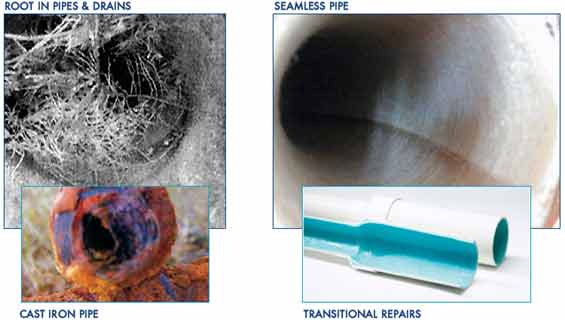

Scraping and Relining
Scraping and relining is applicable to old tuberculated CI mains, which are structurally sound. Pipe scraping methods include drag scraping, power boring and pressure scraping..Pigs or aggressive swabs comprise plastic swabs incorporating grades of wire brush or studs. For harder encrusted materials, several passes may be necessary and it is essential to have a good flow of water past the device to prevent debris accumulating in front of it. Scrapping with pigs is effective in removing hard deposits, but can also damage and remove linings. Aggressive cleaning is therefore usually followed, by applying a secondary lining to the pipe. Service connections off the main must be isolated and, after cleaning and relining, must be blown back with fresh water. The cleaning and relining processes is also likely to dislodge, damage or block ferrule connections, so excavation to these and their repair may also be required, increasing the cost of rehabilitating the main.
Pipe lining methods
Cement mortar and epoxy resin linings applied to the cleaned internal surfaces of cast iron mains can improve the hydraulic capacity of a pipe and reduce discolouration caused by corrosion. In situ linings can be applied to pipes from 75mm diameter upwards. Cement mortar linings are typically 4 to 6 mm thick. For pipes up to 150 mm diameter, the reduction in pipe bore due to lining and relative roughness of the mortar surface, may not provide adequate hydraulic capacity. Epoxy resins are used for lining mains up to 450 mm in diameter. The finished lining thickness is one to two milimetre, has a projected life of up to 75years, and is very smooth providing a good hydraulic performance with no water quality problems. The lining can be applied to most pipe materials, not only iron and steel mains; but care has to be taken to ensure the epoxy lining makes proper adherence to the wall of the pipe.
Human Resources
Plans, programs, facilities and systems alone are not enough to assure the reliability of the distribution system. The importance of the human factor must not be underestimated. In fact, some of the greatest ideas have failed because the human factor was not properly considered. The distribution system’s reliability ultimately depends on the managers’ and operators’ ability to understand and apply the programs and state-of-the-art technology with confidence in the system and their own abilities.
Some best management practices for enhancing distribution system reliability through human resources include:
-
Licensing operators
-
Conducting on-going training programs
-
Developing a multi-skilled workforce
Leave a Reply







 LIKE TO GET UPDATES
LIKE TO GET UPDATES  TO GET EXPERT GUIDE
TO GET EXPERT GUIDE